Perissone Cambio: Madrigals for Four Voices
In 1547 Perissone published with Gardane his Primo libro di madrigali a quatro voci — as it turned out, the only four-voice madrigal book to be issued by any of Willaert's immediate students.[55] Like Perissone's other books, the Primo libro a 4 is arranged in ascending modal order — at least through no. 22, the end of the consecutive block of madrigals that are Perissone's own (see Table 12). The modal ordering extends to distinctions between authentics and plagals (unlike the Segondo libro a 5 ), albeit with a few anomalies.[56] Nothing else unites the book, however, and otherwise it is Perissone's most diverse, merging in a single collection the widely disparate generic traditions that attached to madrigals for four voices, on the one hand — chansonesque madrigals à la Verdelot and Arcadelt, madrigals for theater, madrigals a note nere, madrigals related to frottole, and songs in the oral tradition — and the
[55] I except the four-voice book of madrigals published by Nicola Vicentino of Vicenza (in the Veneto) in 1546 because it bears so little relation to the style that Willaert's Venetian circle was pursuing at the time; see Del unico Adrain Willaerth discipulo don Nicola Vicentino madrigali a cinque voci per theorica et pratica da lui composti al nuovo modo dal celeberrimo suo maestro ritrovato. Libro primo (Venice, 1546); mod. ed. Nicola Vicentino, Opera omnia, ed. Henry W. Kaufmann, Corpus mensurabilis musicae, no. 26, AIM ([Rome], 1963), pp. 1-60.
| ||||||||||||||||||||||||||||||||||||||||||||||||||||||||||||||||||||||||||||||||||||||||||
(table continued on next page)
(table continued from previous page)
| ||||||||||||||||||||||||||||||||||||||||||||||||||||||||||||||||||||||||||||||||||||||||||||||||
generally more monolithic, learned traditions of five- and six-voice madrigals, especially of sonnet settings, on the other.
Perissone's book included sonnets, ballate, cinquecento madrigals, and ottave rime. Not all of these had lately been linked to four -voice settings and certainly not mixed in a single volume. Of the twenty-six numbers, the largest share (predictably) are settings of cinquecento madrigals, eleven of them by Perissone (nos. 1, 2, 6, 8, 10, 15, 16, 18, 20, 22, and 26) and three by Cipriano de Rore (nos. 23, 24, and 25).[57] Rore's contributions include the first publication of his setting of Alfonso d'Avalos's Anchor che col partire, one of the most often reprinted and imitated secular settings of the century. Einstein may have overstated the case in calling it the model for the whole collection,[58] but it has suggestive stylistic parallels with Perissone's many madrigal settings in the book.
Sonnet settings, by comparison, total only five — all Petrarch's and all complete (nos. 3, 12, 14, 17, and 21). This makes Perissone's emphasis on madrigals over sonnets an apparent emphasis of Rore's four-voice model over the four-voice madrigals in the Musica nova . Yet it is Perissone's sonnet settings that are newest and that introduce the single most significant dichotomy in the collection. Perissone was the only one of Willaert's disciples to write four-voice settings of Petrarch's sonnets in a style close to the Musica nova. Four of them in fact set Musica nova texts: Io amai sempre & amo fort'ancora (the only one also for four voices in Willaert's setting), In qual parte del ciel, Più volte già dal bel sembiant'humano, and Pien d'un vago pensier. We might add to the book's weightier sonnet side its two ballata settings, no. 11, Come potrò fidarmi, Brevio's Cantai mentre ch'i arsi (earlier published in settings by Rore and Parabosco), as well as the anonymous Amor, da che tu voi (no. 22), set in two parts (like Willaert's setting of 154-8 and Perissone's of 1550).
None of the poems I have placed in this group is shorter than twelve lines long. By contrast, only one of the madrigal texts (apart from no. 22) is longer than nine lines (no. 8), including Rore's. These tiny poems generally concentrate on a single, concisely developed conceit. The slight literary status they claimed in musical prints may have been nil outside of music: except for those by Cassola (no. 15) and d'Avalos, all the madrigal texts are as yet anonymous.
To complete this sketch of the book's contents, the four remaining numbers are ottave rime. One of them is Bembo's (no. 5), another a stanza from Ariosto's Orlando furioso, 24.1 (no. 7), and the other two (nos. 4 and 19) again anonymous. Ottave rime are among the least common forms to appear in contemporary Venetian collections. With their lucid songlike textures and avoidance of contrapuntal artifice, they fall more on the madrigalian than the sonnet side of Venetian production. Their form — endecasillabi rhyming ABABABCC — was a long-standing
[57] Perissone's setting of the first seven lines from Petrarch's canzone Perchè la vit'è breve (no. 9) might just as well be added to this group, as it functions similarly to the madrigals, extracting the piedi and the first line of the sirima from the opening stanza.
[58] The Italian Madrigal 1:441.
vehicle of poet-improvisors in the oral tradition, the structural prototype shared by epic poetry and the lyric strambotto, as well as occasional stanzas. Thus their presence in the Primo libro a 4 may signal yet again the enduring connection between settings of ottave rime and traditions of improvisatory song.[59]
This brings us to the dedication attached to the collection, made to the renowned Paduan poet Gaspara Stampa who was famed for her singing to the lute.
To the lovely and talented Signora Gasparina Stampa
Noble lady, well might I be reproved by the wise and learned composers of this sweet and admirable science — reproved in this science, yes, but no man in the world will ever be able to say that I have had little judgment in dedicating these notes of mine to your ladyship, however they may be. Because it is well known by now — and not only in this fortunate city, but almost everywhere — that no woman in the world loves music as much as you do, nor possesses it to such a rare degree. And thousands upon thousands of fine and noble spirits attest to this who, having heard your sweet harmonies, have given you the name of divine siren, remaining over time your most devoted servants, among whom I am as devoted as any. I come with this my little token and gift to refresh the memory of the love that I bear for your talent, begging that you deign to find me worthy to be placed where you place the innumerable throngs of those who adore and love your rare talents and beauties. And to your graces I commend and offer myself. Most devoted servant Pieresson Cambio.[60]
In Chapter 4, I suggested that a connection might exist between the kind of solo and at least quasi-improvisatory singing for which Stampa was acclaimed and the treble-dominated writing and periodic phraseology that pervades much of Perissone's four-voice book. Even though his published settings were suited to part singing, it is reasonable to imagine alternatively that at least some of them could have been adapted for solo singing to lute accompaniment or simply been performed by a solo treble singer to the accompaniment of viols or broken consort on the lower parts. Perissone's plea to be placed among Stampa's adoring throngs
[59] On this matter and in connection with the discussion that follows see Chap.4 nn. 68-80 above, esp. the literature cited in n. 75. See also James Haar, "Arie per cantar stanze ariotesche," in L'Ariosto: la musica, i musicisti, ed. Maria Antonella Balsano (Florence, 1981), pp. 31-46, and idem, Essays on Italian Poetry and Music in the Renaissance, 1350-1600 (Berkeley and Los Angeles, 1986), pp. 92-99.
[60] Alla bella et virtuosa Signora Gasparina Stampa
Valorosa signora, io potrò ben esser ripreso apresso ai saggi, & dotti compositori di questa dolce et mirabile scienza: in essa scienza ma no mi potra gia huomo del mondo dire giamai ch'io habbia havuto poco giuditio nel dedicare queste mie note, quale elle siano, alla S.V. perche si sa bene homai. & non pure in questa felice citta: ma quasi in ogni parte, niuna donna al mondo amar piu la Musica di quello che fate voi, ne altra piu raramente possederla, & di questo ne fanno fede i mille, & mille spirti gentili, & nobili: i quali udito havendo i dolci concenti vostri, v'hanno dato nome di divino sirena, restandovi per tempo devotissimi servi, fra i quali, io devoto quanto altro, vengo con questo mio picciolo segno & presente, a rinfrescarle nella memoria, lo amore ch'io porto alle sue virtu, pregandola che si degni, ch'io sia degno di esser posto dove ella pone la innumerabil turba di quei ch'adorano, & amano le sue rare virtu, & bellezze. & alla sua bona gratia mi raccomando & offero. Devotissimo servo Pieresson Cambio.
might be glossed as a hope that his songs will grace her repertory. It might also have been a way of insinuating himself as fellow singer in the elect circles of literary academists with which Stampa surrounded herself in various private homes, including her own. To say so is to suggest that a four-voice book of the 1540s might still have functioned at times as a sort of fakebook — as books of frottole had done — providing raw material to be freely adapted according to variable needs. One of its specific functions may have been that of a solo songbook (also like books of frottole), thus continuing the alliance of early madrigals with solo song made so patent by Willaert's intabulations of Verdelot's madrigals a decade earlier.[61]
Vestiges of recitational practice from unwritten traditions are embedded in Perissone's setting of Ariosto's stanza Chi mett'il pie su l'amorosa pania from Orlando furioso, the central textual repository for sixteenth-century improvvisatori (Ex. 52).
Chi mett'il pie su l'amorosa pania May he who puts his foot in the loving birdlime
Cerchi ritrarlo e non inveschi l'ale, Try to extract it and not catch his wing [in it],
Che non è in somm'Amor se non l'insania For in the end Love is nothing but madness
A giuditio de savi universale; In the universal opinion of wise men;
E se ben egualment'ogn'huom non smania, And if everyone does not go raving about equally,
Suo furor mostrar'a qualch'altro segnale; Its furor shows itself through other signs;
E qual è di pazzia segno pi& espresso And what is a more telling sign of madness
Che per altri voler perder se stesso? Than to lose your own self by desiring another?
Each of the stanza's eight lines is fitted to a distinct musical strain. None but the last receives a full repeat, and only the most minimal textual repetition occurs otherwise. Simultaneous declamation simulating accompanied solo singing plays a prominent role here, as it does in the other ottava settings, all but one of which begin in homorhythm. Homorhythm also helps articulate the couplets that organize the octave at the highest level: while cadences at line endings reinforce the sense of organization by melodic strains, the junctures between couplets are reinforced texturally by four-voice homophony (if only up to the cadence — compare mm. 8 and 14 with m. 18). At another level of formal articulation, Perissone's setting reproduces musically the effect of various textual rhymes by giving them similar cadences, like the ones ending vv. 3 and 5, "sania" / "smania" (mm. 10 and 16). Meanwhile, as in other ottava settings, the bass line moves much more harmonically than in Perissone's settings of other sorts of verse. This is not to underestimate Perissone's use of contrapuntal artifice or his exploitation of counterpoint to achieve cadences of varying weights: weakening the cadence of v. 1 (m. 3) by delaying the diminished suspension in the cantus, evading the cadences in mm. 13 and 14 for v. 4, or overlapping seams between vv. 7 and 8 (mm. 21-22). It is rather to point
[61] Intavolatura de li madrigali di Verdelotto da cantare et sonare nel lauto, intavolati per Messer Adriano (Venice, 1536); Renaissance Music Prints, vol. 3, ed. Bernard Thomas (London, 1980); facs. ed. Archivum Musicum, Collana di testi rari, no. 36 (Florence, 1980).
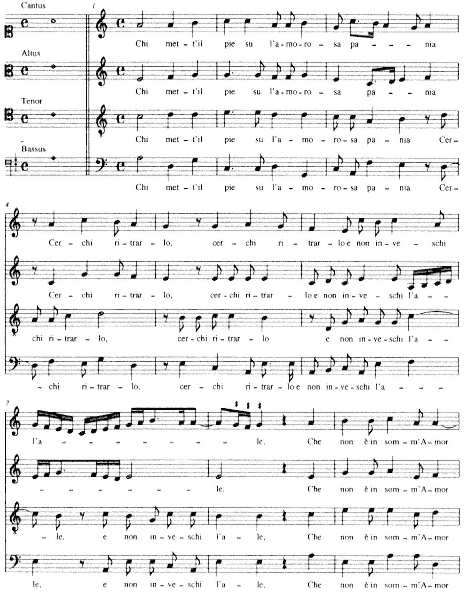
Ex. 52.
Perissone, Chi mett'il pie su l'amorosa pania (Ariosto), incl.;
Primo libro a 4 (Venice, 1547), no. 7.
(continued on next page)
(continued from previous page)
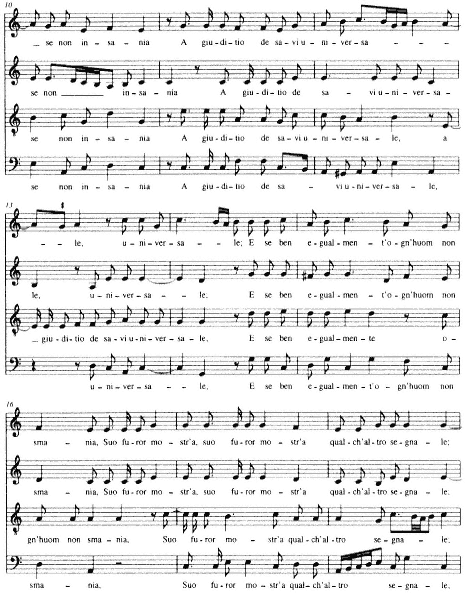
Ex. 52
(continued)
(continued on next page)
(continued from previous page)
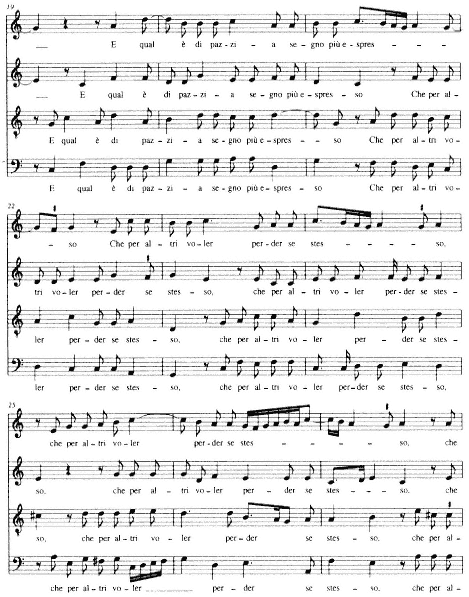
Ex. 52
(continued)
(continued on next page)
(continued from previous page)
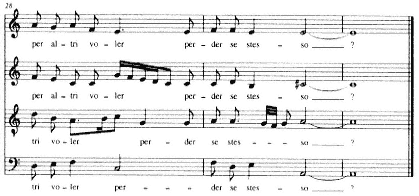
Ex. 52
(continued)
up the fortuitous merging of written contrapuntal with oral soloistic procedures that Perissone effects in settings like this.
Perissone's four-voice settings of madrigals avoid the signs of oral recitation that mark his ottava settings, though without aiming for a higher literary tone. Madrigals elicit more extensive text repetition and far more radical displacements of poetic lines between contrapuntal parts. (In no. 10, for example, the tenor is nearly three measures and fully one poetic line ahead of all three other voices by the end of m. 6.) Instead of playing a continuously harmonic role, bass lines in madrigal settings are inclined to alternate between two roles, that of harmonic support and that of equal participant in the imitative processes governing the whole texture.
Many of the madrigal texts are addressed directly to women in the form of serenades: Vaga tranquilla e lieta (no. 2, to a "Marina"), Duo più potenti lumi (no. 6), and Chiara luce serena (no. 8). Moving away from the sectionalizing strategy of the frot-tola, Perissone's settings give a continuous musical development to their amorous conceits, which invariably crest in a witty point at the end, rather than "[touching on] the principal motif . . . in the first line" or an opening ripresa, as happens in barzellette.[62] According to Parabosco (as he has Speroni declare in I diporti ), both madrigals and strambotti resemble epigrams in sharing this sort of development.[63] Whereas Perissone's ottava settings reproduce the segmented techniques of solo recitation and rely on rhythmic energy for momentum, his madrigal settings mirror their poems' rhetorical trajectory by piling up voices, displaced in imitation, into a contrapuntal crescendo.
[62] The quote is from Einstein, The Italian Madrigal 1:185.
[63] "Above all else," he writes, "the madrigal and strambotto must have a lovely wit and invention, just like an epigram" (sopra ogni altra cosa, il madrigale e lo strambotto vuole andare vago d'arguzia e di invenzione, sì come apunto vuole apparire il motto); I diporti (Venice, [ca. 1550]; repr. in Novellieri minori del cinquecento: G. Parabosco — S. Erizzo, ed. Giuseppe Gigli and Fausto Nicolini [Bari, 1912]), p. 177; a longer excerpt, which includes this passage, is quoted and trans. in Einstein, The Italian Madrigal 1:184-85.
Both approaches could draw on aspects of madrigalistic repertories from the 1530s, though in different ways. By contrast, Perissone's sonnet settings a 4 tend toward denser polyphony and more learned diction (if less so than his sonnets set a 5 ). While indebted to Willaert's settings, his sonnets a 4 are less solemn and ample than Willaert's or Rore's settings a 5 or 6 . Perissone's four-voice In qual parte del ciel, for instance, falls short of Willaert's for six voices by twenty-two breves. The prima parte of Willaert's six-voice Pien d'un vago pensier alone is longer than the whole of Perissone's four-voice setting of it (73 and 72 breves, respectively; Willaert's setting lasts 128 breves altogether).[64] Discrepancies like these are to be expected, given that contrapuntal complexities normally increase geometrically as voices are added. But differences also arise because Perissone tended to make his four-voice sonnet settings lighter, more condensed, and simpler in construction, with voices more frequently arranged in homophony or closely interwoven, and with somewhat less radically evaded cadences than Willaert did.[65]
Perissone's setting of the sonnet Più volte già (no. 14) embodies many of these differences. Like In qual parte del ciel and Pien d'un vago pensier, the setting is much shorter than Willaert's, with each line normally stated once, or at most repeated only partially. Whereas Willaert's exposition of Più volte già opened the a - and o - laden first verse in a languorous, irregular point of imitation, Perissone's opening ascends in chansonlike dactyllic tetrachords located in a regularized, efficient exposition (Exx. 53a and 53b). Willaert ambles through six breves before accelerating into a minim pace; Perissone establishes the minim as the basic declamatory pulse in the first measure. Perissone returned to this laconic style for the polysyndetonic vv. 6 and 7: (Exx. 54a and 54b): "Per ch'ogni mia fortuna, ogni mia sorte, / Mio ben, mio male, et mia vita et mia morte" (for all my fortune, all my destiny, my good, my ill,
[64] Overall the four-voice settings in the Musica nova average about the same length as those for more voices and are about half again as long as the four-voice sonnet settings of Perissone.
[65] On works in the Primo libro a 4 that are modeled on settings in the Musica nova — In qual parte del ciel and Amor, da che tu voi — see Helga Meier, "Zur Chronologie der Musica Nova ," pp. 84-87, and the preface to idem, ed., Fünf Madrigale, pp. iii-iv. The latter, she notes, is unique for borrowing its exposition (like Perissone's five-voice setting of the same poem, published in 1550) not from a setting by Willaert of the same text but rather from one that merely begins with the same word, Amor, fortuna, et la mia mente. Perissone's habit of modeling took a unique form in his four-voice setting of In qual parte del ciel, which borrowed extensively only after the exposition. Meier cites two of these borrowings, one in the motive at v. 3, "Quel bel viso leggiadro" (mm. 18-20; cf. Willaert, mm. 18-21), and the other in the latter half of v. 5, "in selva mai qual dea" (mm. 33-35; cf. Willaert, mm. 36-47). In addition to emphasizing a C tonality, other correspondences may be cited as follows: Perissone's adoption of various aspects of Willaert's interpretation of v. 6, "Chiome d'oro sì fino a l'aura sciolse?" (Perissone, mm. 35-40; Willaert, mm. 45-52); the polymetric combination of tonic and agogic accents on the initial syllable "Chio-" of "Chiome d'oro"; and motivic similarities throughout the respective settings of vv. 12 and 13. The opening of the seconda parte, while not taken over as precisely in Perissone's version a 4 as in that a 5 , nonetheless borrows both the rhythm and general melodic direction of Willaert's original. Willaert's five opening sonorities — A-D-G-C-a — are also all present. Though Perissone reverses the order of the first two, he was apparently reconciling a harmonic imitation of Willaert's setting with the exigencies of his counterpoint, transposing A and D to permit a smooth transition from the prima parte and retain Willaert's colorful C-sharp on "divina" in the uppermost voice. This allowed him to adopt much of the sonority of Willaert's passage despite using a different mode. On the whole Perissone's setting is more tuneful and melodically more far-ranging than its model. In the exposition, for instance, where Willaert's opening is plain, full of repeated notes in small ambituses and devoid of rhythmic surprise, Perissone's lines sweep quickly over large areas of pitch space.
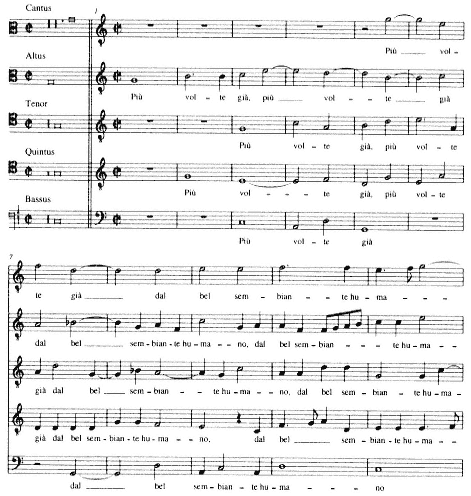
Ex. 53A.
Willaert, Più volte già, dal bel sembiante humano (Petrarch, no. 170),
mm. 1-11; Musica nova (Venice, 1559), no. 6.
my life, and my death). Where Willaert had assigned a separate gesture to each rhetorical parcel, casting "mio ben/mio male" into a kind of dialogue (altus-tenorquintus-bassus, mm. 47-49, answered by cantus-altus-tenor-quintus, mm. 49-51) and drawing out "e mia vita, e mia morte" in a madrigalistic rendering, Perissone set the same clause more plainly (mm. 38-41), phrasing the entire chain of possessives, save "mia fortuna," in a single, quasi-continuous gesture (mm. 31-41). Only the final verse broadens out through a series of textual repetitions marked by perfect cadences (mm. 76 and 84, as traditionally happens toward the end of a madrigal), and finally syncopated embellishment in the tenor.
It thus seems clear that Perissone's less expansive approach to sonnets reflects a continued tendency to view the four-voice madrigal as a qualitatively different
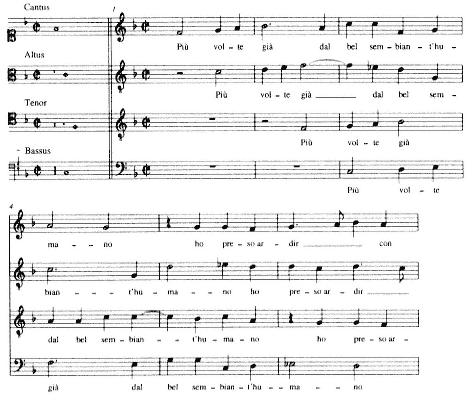
Ex. 53B.
Perissone, Più volte già dal bel sembiant'humano (Petrarch, no. 170),
mm. 1-6; Primo libro a 4 (Venice, 1547), no. 14.
genre from madrigals for five or six voices or those for seven or eight. Yet his Più volte già also conforms to many other instances in which Willaert's disciples hesitated to embrace completely the restrictive seriousness that Willaert brought to Musica nova madrigals.
Although Perissone's career as chapel singer and freelancer continued to flourish in the 1550s,[66] no further collections devoted to his music have come down to us after that of 1550. A few of his works were anthologized up until 1576, but sometime during the 1560s Perissone passed away.[67] His death was mourned in Petrarchan tropes exchanged by two Venetian academists, Domenico Venier and Girolamo Fenaruolo: "The sound
[66] See Jonathan Glixon, "A Musicians' Union in Sixteenth-Century Venice," JAMS 36 (1983): 409-10 n. 42, and Ongaro, "The Chapel of St. Mark's," pp. 140-41 and 145.
[67] See the mentions of his death in documents from the Scuola di San Marco and the Scuola di Santa Maria della Carità reported by Glixon, "A Musicians' Union," pp. 409-10 n. 42. He may have died earlier than the late sixties, as suggested by his absence from the lists of singers at St. Mark's from 1562; see Ongaro, "The Chapel of St. Mark's," p. 165 n. 194, and Document 272.
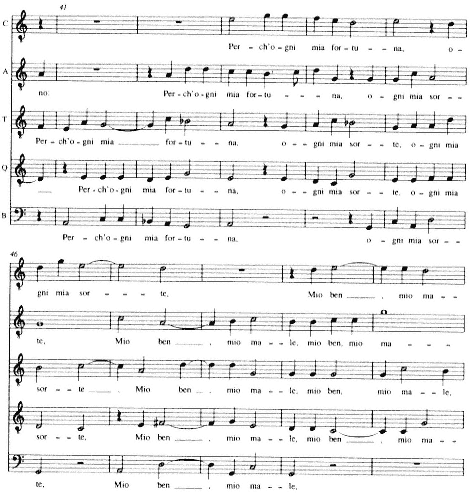
Ex. 54A.
Willaert, Più volte già dal bel sembiante humano (Petrarch, no. 170),
mm. 41-50; Musica nova (Venice, 1559), no. 6.
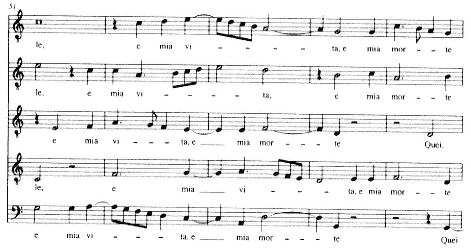
Ex. 54A
(continued)
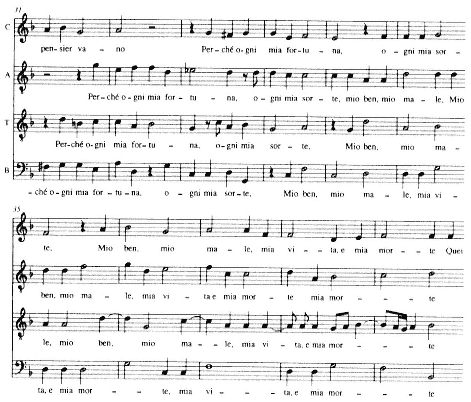
Ex. 54B.
Perissone, Più volte già dal bel sembiant'humano (Petrarch, no. 170),
mm. 31-41; Primo libro a 4 (Venice, 1547), no. 14.
of his sweet tones stopped / the waves in the sea, the wind in the air, / burned ice, moved mountains, and made serene the clouded sky."[68]